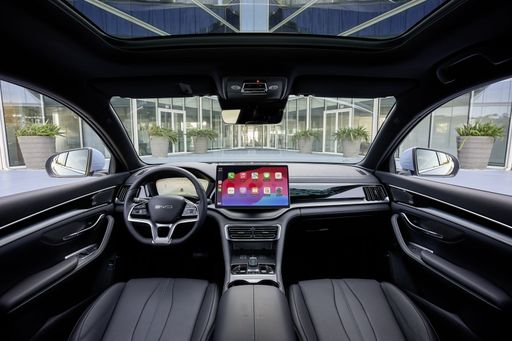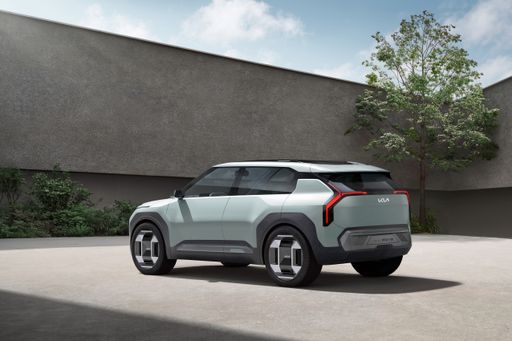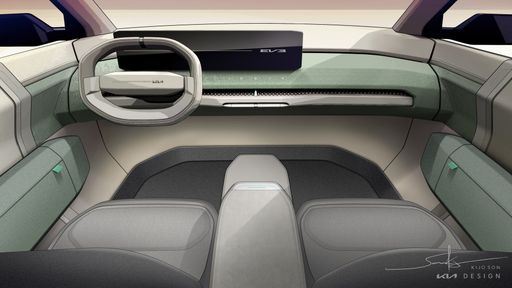As electric vehicles continue to gain traction in the automotive market, the competition is heating up between leading manufacturers. Two noteworthy contenders in the SUV segment are the BYD Seal U and the Kia EV3. Both models offer impressive features, innovative technologies, and the aim to meet the demands of the environmentally-conscious consumer. In this article, we will delve into a detailed comparison of these two vehicles, focusing on their technical specifications and innovations.
BYD Seal U vs Kia EV3 – Which model is better for everyday use?
Both models have their strengths – but which one suits you more?
Compare performance, efficiency, price and space directly: BYD Seal U or Kia EV3?
Body Design and Dimensions
Starting with body type, both the BYD Seal U and Kia EV3 are classified as SUVs, offering a spacious dimension for comfort and utility. The Seal U measures 4775 mm in length, making it longer than the EV3, which ranges from 4300 to 4310 mm. The width of the Seal U stands at 1890 mm, while the EV3 is slightly narrower at 1850 mm. In terms of height, the Seal U has a notable height of 1670 mm compared to the EV3's maximum of 1570 mm, indicating a more commanding presence on the road for the BYD. Both models offer five doors and can accommodate up to five passengers comfortably.
Power and Performance
The performance of an electric vehicle hinges on its powertrain and battery efficiency. The BYD Seal U features a dual-engine setup with a maximum output of up to 324 HP and a torque of 550 Nm, showcasing its superior performance capabilities. In comparison, the Kia EV3 offers a single-motor layout with a maximum power output of 204 HP and torque of 283 Nm.
When it comes to acceleration, the Seal U shines with a 0-100 km/h time of just 5.9 seconds in its most powerful configuration, while the EV3 completes the same sprint in 7.5 to 7.9 seconds. Both models reach a maximum speed of 170 km/h, aligning their performance on highways.
Range and Efficiency
Range plays a pivotal role in the choice of electric vehicles. The BYD Seal U offers a remarkable electric range varying up to 500 km, depending on the setup. Although the EV3 also provides commendable ranges of 436 km to 605 km, it is particularly appealing for those looking for day-to-day practicality. In terms of energy consumption, the Kia EV3 boasts a more efficient consumption rate of 14.9 to 16.2 kWh/100 km, compared to BYD's 19.9 to 20.5 kWh/100 km, making the Kia a standout in efficiency.
Battery and Charging
Battery size and capability significantly influence driving range and convenience. The BYD Seal U offers multiple configurations, including battery options that provide capacities of 60 liters for gasoline, while its electric battery range extends to 81.4 kWh. In contrast, the Kia EV3 presents a battery capacity of 58.3 to 81.4 kWh, giving it a practical edge for urban commuting and longer trips alike.
Interior and Technology
Interior comfort and technological innovations are paramount in today’s automotive industry. The BYD Seal U emphasizes trunk capacity with an impressive 552 liters, making it practical for families and adventures. Meanwhile, the Kia EV3 offers 460 liters of storage, ensuring ample space for everyday use. Both vehicles offer advanced technological features, though specific interior tech specifications remain a pivotal selling point for prospective buyers seeking connectivity and infotainment options.
Conclusion
In conclusion, both the BYD Seal U and Kia EV3 represent significant advancements in the electric SUV market, each catering to diverse consumer needs. The Seal U excels in performance, range, and trunk capacity, while the EV3 showcases superior efficiency and innovative styling. Ultimately, the choice will depend on individual preferences regarding power, range, and overall practicality. With the ongoing evolution of electric vehicles, consumers can expect even greater competition and innovation in the years to come.
Here’s where it gets real: The technical differences in detail
Costs and Efficiency:
Price and efficiency are often the first things buyers look at. Here it becomes clear which model has the long-term edge – whether at the pump, the plug, or in purchase price.
Kia EV3 has a to a small extent advantage in terms of price – it starts at 30800 £, while the BYD Seal U costs 34300 £. That’s a price difference of around 3429 £.
In terms of energy consumption, the advantage goes to the Kia EV3: with 14.90 kWh per 100 km, it’s evident more efficient than the BYD Seal U with 19.90 kWh. That’s a difference of about 5 kWh.
As for range, the Kia EV3 performs to a small extent better – achieving up to 605 km, about 105 km more than the BYD Seal U.
Engine and Performance:
Power, torque and acceleration are the classic benchmarks for car enthusiasts – and here, some clear differences start to show.
When it comes to engine power, the BYD Seal U has a noticeable edge – offering 324 HP compared to 204 HP. That’s roughly 120 HP more horsepower.
In acceleration from 0 to 100 km/h, the BYD Seal U is distinct quicker – completing the sprint in 5.90 s, while the Kia EV3 takes 7.50 s. That’s about 1.60 s faster.
In terms of top speed, the BYD Seal U performs slight better – reaching 180 km/h, while the Kia EV3 tops out at 170 km/h. The difference is around 10 km/h.
There’s also a difference in torque: BYD Seal U pulls significantly stronger with 550 Nm compared to 283 Nm. That’s about 267 Nm difference.
Space and Everyday Use:
Whether family car or daily driver – which one offers more room, flexibility and comfort?
Both vehicles offer seating for 5 people.
In curb weight, Kia EV3 is barely noticeable lighter – 1800 kg compared to 1940 kg. The difference is around 140 kg.
In terms of boot space, the BYD Seal U offers to a small extent more room – 552 L compared to 460 L. That’s a difference of about 92 L.
In maximum load capacity, the BYD Seal U performs to a small extent better – up to 1465 L, which is about 214 L more than the Kia EV3.
When it comes to payload, Kia EV3 to a small extent takes the win – 470 kg compared to 410 kg. That’s a difference of about 60 kg.
Who wins the race?
The BYD Seal U proves to be wins the duel decisively and therefore becomes our DriveDuel Champion!
BYD Seal U is the better all-rounder in this comparison.
 @ BYD Auto / BYD Global Media
@ BYD Auto / BYD Global Media
BYD Seal U
BYD Seal U
The BYD Seal U pairs a sleek fastback silhouette with a surprisingly roomy, tech-rich cabin, giving electric chic without the showroom pretension. It's a smart pick for buyers after confident handling, sensible practicality and standout value — all wrapped up with a cheeky grin when you put your foot down.
details @ BYD Auto / BYD Global Media
@ BYD Auto / BYD Global Media
 @ BYD Auto / BYD Global Media
@ BYD Auto / BYD Global Media
 @ BYD Auto / BYD Global Media
@ BYD Auto / BYD Global Media
Kia EV3
The Kia EV3 arrives as a cheeky, practical electric compact that manages to feel both premium and playful, delivering crisp handling and a roomy cabin that's perfect for urban life. With smart tech, friendly styling and sensible pricing, the EV3 is the kind of car that makes switching to electric feel like a no-brainer without asking you to give anything important up.
details @ Kia Corporation
@ Kia Corporation
 @ Kia Corporation
@ Kia Corporation
 @ Kia Corporation
@ Kia Corporation
 @ BYD Auto / BYD Global Media
@ BYD Auto / BYD Global Media
|
 @ Kia Corporation
@ Kia Corporation
|
|
|
|
Costs and Consumption |
|
|---|---|
|
Price
34300 - 39800 £
|
Price
30800 - 41700 £
|
|
Consumption L/100km
0.4 - 1.2 L
|
Consumption L/100km
-
|
|
Consumption kWh/100km
19.9 - 20.5 kWh
|
Consumption kWh/100km
14.9 - 16.2 kWh
|
|
Electric Range
70 - 500 km
|
Electric Range
436 - 605 km
|
|
Battery Capacity
-
|
Battery Capacity
58.3 - 81.4 kWh
|
|
co2
0 - 26 g/km
|
co2
0 g/km
|
|
Fuel tank capacity
60 L
|
Fuel tank capacity
-
|
Dimensions and Body |
|
|---|---|
|
Body Type
SUV
|
Body Type
SUV
|
|
Seats
5
|
Seats
5
|
|
Doors
5
|
Doors
5
|
|
Curb weight
1940 - 2147 kg
|
Curb weight
1800 - 1885 kg
|
|
Trunk capacity
425 - 552 L
|
Trunk capacity
460 L
|
|
Length
4775 - 4785 mm
|
Length
4300 - 4310 mm
|
|
Width
1890 mm
|
Width
1850 mm
|
|
Height
1668 - 1670 mm
|
Height
1560 - 1570 mm
|
|
Max trunk capacity
1440 - 1465 L
|
Max trunk capacity
1251 L
|
|
Payload
410 kg
|
Payload
470 kg
|
Engine and Performance |
|
|---|---|
|
Engine Type
Plugin Hybrid, Electric
|
Engine Type
Electric
|
|
Transmission
Automatic
|
Transmission
Automatic
|
|
Transmission Detail
CVT, Reduction Gearbox
|
Transmission Detail
Reduction Gearbox
|
|
Drive Type
Front-Wheel Drive, All-Wheel Drive
|
Drive Type
Front-Wheel Drive
|
|
Power HP
218 - 324 HP
|
Power HP
204 HP
|
|
Acceleration 0-100km/h
5.9 - 9.6 s
|
Acceleration 0-100km/h
7.5 - 7.9 s
|
|
Max Speed
170 - 180 km/h
|
Max Speed
170 km/h
|
|
Torque
300 - 550 Nm
|
Torque
283 Nm
|
|
Number of Cylinders
4
|
Number of Cylinders
-
|
|
Power kW
160 - 238 kW
|
Power kW
150 kW
|
|
Engine capacity
1497 - 1498 cm3
|
Engine capacity
-
|
General |
|
|---|---|
|
Model Year
2024
|
Model Year
2024
|
|
CO2 Efficiency Class
B, A
|
CO2 Efficiency Class
A
|
|
Brand
BYD
|
Brand
Kia
|
What drive types are available for the BYD Seal U?
The BYD Seal U is available as Front-Wheel Drive or All-Wheel Drive.
The prices and data displayed are estimates based on German list prices and may vary by country. This information is not legally binding.
